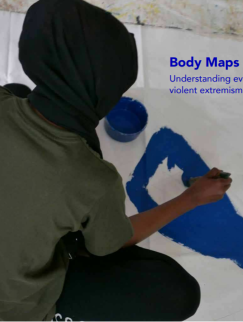This book explores how men and women at the level of local communities perceive, experience, and resist violent extremism in their everyday lives. The book gives voice to silenced narratives on communities’ everyday resistance to violent extremism. The inputs for the book are based on a series of workshops, in addition to interviews and focus group discussions, with a individuals from diverse ethnic and religious backgrounds across Nairobi, Mombasa, and Kwale, Republic of Kenya.
This book features a collection of essays that underline the experiences of workshop participants struggling with violent extremism, and their resistance to it. The book is divided into three sections: the first section presents context for the research; the second outlines body mapping as a research methodology, and the third is dedicated to the composition of workshop participants, including their personal narratives about violent extremism and resistance.
The personal narratives ultimately explore how men and women at the community-level perceive, experience, and resist violent extremism differently in their daily lives. The book gives voice to marginalized narratives from a community perspective surrounding resistance to violent extremism. The qualitative data reveals complex challenges against violence, discrimination, and marginalization. Collectively, the narratives suggest that violent extremism is significantly influenced by instances of police brutality, tribalism, marginalization, and organized crime, while also suggesting that other forms of violence contribute to violent extremism. The narratives also offer insights into how programmes and policies could better support counter-terrorism and preventing/countering violent extremism (CT/PCVE), namely through community-level activities such as theatre, art, fashion, comedy, and community spaces.
